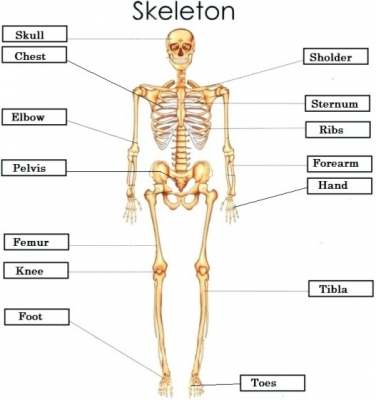
SKELETON
Constructed from 206 bones, the human skeleton is a strong, flexible framework that supports and shapes the body and produces movement when pulled by muscles. The skeleton also protects soft, internal organs, such as the brain and lungs. Bones, which makes up 20 per cent of the body’s mass, are connected to each other at joints and are held together by strong straps of tissue called ligaments.
- SKULL The bones in the skull protect the brain, provide a framework for the face, and anchor the muscles that produce facial expressions. The skull consists of 22 bones, 21 of which are locked together by immovable joints called sutures. Only the lower jaw (mandible) can move.
- CHEST The bones of the chest (thorax) consist of the sternum (breastbone), the ribs, and part of the backbone. Together, they form a protective “cage” that protects the lungs and the heart.
- FOREARM The forearm is made up of two parallel bones – the ulna and the radius. The ulna curves round the humerus to form the elbow’s point, while the radius forms a joint with the carpals (wrist bones).
- ELBOW The bones of the upper arm and forearm meet at the elbow. This joint acts like a door hinge allowing the arm to bend or straighten. The forearm bones can rotate at the elbow, enabling the palm of the hand to face upwards or downwards.
- KNEE The knee joint between the femur (thigh bone) and tibia (shin bone) is the strongest and most complex joint in the body. This hinge joint allows the leg to bend or straighten and supports the body’s weight during activities such as running, jumping, or kicking.
- PELVIS This strong, bowl-shaped structure consists of the two curved hip bones (pelvic girdle) and the sacrum. The pelvis supports the abdominal organs and attaches the thigh bones to the rest of the skeleton.
- HAND Hinged at the wrist, the hand consists of 27 bones and many movable joints (knuckles), which enable it to perform a wide range of tasks. The human thumb is opposable, which means that it can be rotated to touch the tips of each of the other fingers.
- FOOT Each foot consists of the ankle, sole, and toe bones, which support and move the body’s weight. These bones also provide a flexible platform that pushes the body off the ground during movement and absorbs the shock on landing.
- TOES The phalanges of the toes are much shorter and less flexible than those of the fingers. The phalanges enable the body to stay upright and to stand on tiptoe. They also help to propel the body forwards during movement.
Picture Credit : Google



